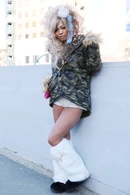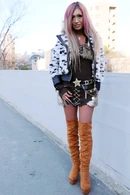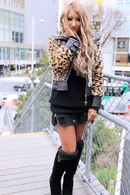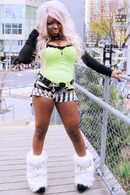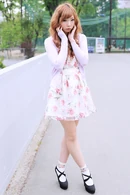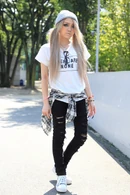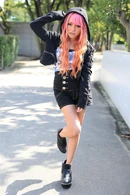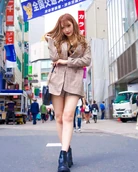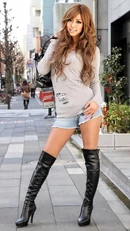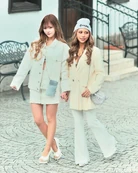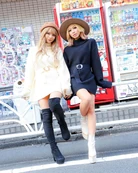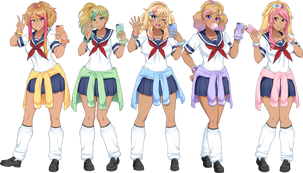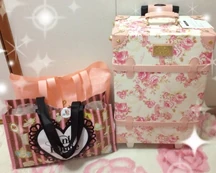Gyaru (ギャル, Gal) is a Japanese subculture that was born as a rebellion against the traditional Asian beauty standards of being pale and showing little skin. While gyaru is generally associated with a particular style, the importance lies in the bold makeup and overall vibe of the outfits rather than wearing a specific fashion. The point is to challenge societal norms by embracing a bold and unapologetic identity that stands out in the crowd.
History[]
The term "Gyaru" is derived from the Japanese spelling of the English word "gal". When it first came into use in Japan during the 1970s, it was mainly used to refer to young, lively women. Only during the 1990s, after Gyaru’s predecessor Bodikon spread in popularity, the term became associated with the subculture of the same name, which highly attracted the attention of the media due to the sheer amount of its followers in Shibuya with their heavy makeup and bleached hair. This specifically happened when Bodikon began to “radicalise” (the look became more extreme, with dyed “chapatsu” (brown), red, and blonde hair, and tanned skin, with barely-there clothing). Before it became a subculture, the style was mainly associated with the fans of the Japanese singer Namie Amuro, who was embracing her tan typical for Okinawans in a time where pale skin was the norm, and the fans imitating her style.
At the height of its popularity, it was not rare to see celebrities (not even just Japanese ones) sporting this style. The tanned skin, big hair, and rebellious outfits went highly against the traditional Japanese beauty standards. While Gyaru appeared very extreme in the past, it toned down as time went on. This can be attributed to a couple of factors; the ageing of many "original" Gyaru from the 1990s and early 2000s into middle-aged people, the continued recession in Japan resulting in a "fatigue" of extreme styles, and the increasingly tame beauty standards of young Japanese people today.
Since the 2020s, there has been a renewed interest in Gyaru fueled by the Heisei Retro boom causing a increased demand for nostalgic styles that were prevalent during the late 1990s and early 2000s. However, to an extent, the outfits have toned down a bit, especially in Japanese communities, with younger “reiwa” gyaru, meaning those who got into the subculture as of 2019, having stark differences to the older “heisei” gyaru. There has also been other changes in the community, like a preference for online shopping on fast fashion sites like Shein rather than shopping for brands in malls, interacting with other gyaru on social media rather than meeting up in public, International/online gal circles becoming more popular, and vlogging and posting on places like Instagram and Tiktok as opposed to blogging. While printed media dedicated to gyaru has mostly become a thing of the past over being able to catch up with the constantly changing trends, there are multiple online magazines "by the community for the community" where gals have taken informing about the latest news within the subculture into their own hands.
Neo-Gyaru[]
“Neo-Gyaru” is an attempt to revitalize the Gyaru style, ongoing since around the late 2010s, during its decline. Neo-Gyaru is notable for its more international adherents when compared to original Gyaru. But when the style reached popularity or even realization that it existed, the Gyaru community reacted in a completely different way then what some anticipated; they completely shunned the style. However, those who were wearing said fashion were not using the same fashion style as before or in its traditional form from apparel to their makeup.
Fashion[]
While Gyaru is mainly defined by its overall styling instead of the clothes worn, there's multiple styles popular among the subculture.
Classic
- Heavily bleached hair
- Droopy eyeliner
- Long fake nails
- Animal print patterns
- Denim mini skirts
- Fuzzy leg warmers
American Casual (Amekaji)
- Bold, brightly coloured prints
- Cute patterns and slogan tees
- Hats are often worn, such as baseball caps and beanies.
- Jeans, shorts and skirts are common; Dresses aren't seen often.
- Simple gyaru makeup
- Tan ranging from medium to heavy
- Lingere aspects such as showing a fancy bra, having garter stockings, and corset lacing.
- Hair is often bleached to various shades of blonde.
- Flat shoes, such as sneakers or ballet flats
Gothic (Goshikku)
- Hair colour is often black, white, grey or blonde. Some other colours are sometimes seen.
- Clothing is almost all primarily black or grey, with sometimes very small amounts of colour or white print.
- Shoes range from platforms, flatforms, heels and dolly shoes.
- Often more understated than Rokku (although studs and pins are seen, not to the excess that is seen in Rokku)
- Makeup is very precise and dark. Lips are either nude or a dark lipstick.
Hostess (Agejo)
- Big, intricate hairstyles. Curls and long hair are the most common.
- Hair is often dyed to be light brown or dark blonde. Darker hair is also common.
- Long nails, often with heavy deco
- Gyaru makeup has very thick eyeliner on top and bottom, with thick lashes
- Dolly-style circle lens, various colors are seen
- Color combinations of clothing is commonly black with pink/white/purple
- Lingerie aspects such as showing a fancy bra, having garter stockings, and corset lacing.
- Tight clothing, often dresses or skirts are worn and very short.
- Brand-name bags and jewelry
Princess (Hime)
- Large beehive-style hair, often with curls
- Hair is often bleached blonde or dyed brown
- Long nails, often with heavy deco
- Lots of pink and white clothing
- Sweet patterns like flowers or gingham
- Makeup is very classic gyaru, with a focus on eyes and soft lip colours
- Heavy deco on accessories such as cell phones
- Lots of lace and bows
- Oversized hair accessories are very common
Rock (Rokku)
- Hair colour can be absolutely any colour
- Makeup focuses on heavy dark eyes or smokey eyes
- Dark lipsticks are common
- Chokers and cross necklaces are staple accessories
- Lots of crosses, studs, leather and rips in clothing
- Tattoos and piercings are common
Romantic (Roma)
- Hair is often ranging from dark brown to medium blonde
- Prints include gingham, polka dot, plaid and floral
- Lace is found on some clothing but not as much as Hime styles
- Boots are often worn, as well as heels with knee-highs
- Hair is often curled and worn down or in a messy up-do
- Makeup is very simple gyaru-style makeup
- Nails are often just plain or French manicured
- There is a focus on comfort and cuteness
Makeup[]
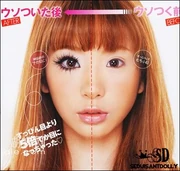
Before and after Gyaru makeup.
Makeup is a central facet of the Gyaru style, and is what separates the many varied fashions from other similar aesthetics. There are differences in makeup depending on the era, but both old and modern Gyaru styling has in common that the focus on eye-enlarging makeup. In the past, this was archived by drawing an exaggerated bottom lash line in combination with wearing multiple layers of fake lashes, but over the years it has become a lot more common to use circle lenses in combination with "eye bag" makeup for a similar effect.
Hair[]
As Gyaru is opposing traditional Japanese beauty standards, there are many people who bleach their hair to an unnatural shade of blonde, but pink and silver dyes are also popular. There is a tendency for wavy-to-curly hairstyles, with long hair being the most popular as it is easier to accessorize.
Media[]
This list contains works that either center around Gyaru or are heavily inspired by its aesthetic.
Characters[]
- Asami Yuki (Higehiro: After Being Rejected, I Shaved And Took In A High School Runaway)
- Junko Enoshima (Danganronpa)
- Kuranosuke Koibuchi
- Kaede (Gal & Dino)
- Kaede Hozuki (Onimai: I'm Now Your Sister!)
- Lords Of Pastimers (Asobi Asobase)
- Marin Kitagawa (My Dress-Up Darling!)
- Mikoto Aiura (The Disastrous Life Of Saiki K.)
- Nana Sunohara (Miss Caretaker of Sunohara-Sou)
- Nami Komatsu (Nana)
- Ran Kirishima (Gal Samurai)
- Ran Kotobuki (Super GALS!)
- Sakura (Don't Toy With Me, Miss Nagatoro)
- Sakura Hibiki (How Heavy Are The Dumbbells You Lift?)
- Shino Goto (Akiba Maid War)
- Stella (Dragon Quest IX)
- Tiara (Love Tyrant)
- Yukana Yame (My First Girlfriend Is A Gal)
- Minami Fuyuki (Hokkaido Gals Are Super Adorable!)
- Yuzuko Aihara (Citrus)
- Asuka Katou (WataMote: No Matter How I Look at It, It's You Guys' Fault I'm Not Popular!)
Manga & Anime[]
- 30-sai Moonna, Heisei Gyaru ni naru.
- Galism
- Gal Japon
- Gal Lawyer
- Gyaru to Bocchi
- Gyaru Samurai
- Inkya Gal Demo Ikigaritai!
- Kechonpa
- Rough Sketch Senpai
- Sayonara ja Nee yo, Baka.
- Supermarket Sweetie
- Uchida-san wa Zettai ni Gyaru ja Nai!
Television[]
- Gals!
- Gal & Dino
- Hajimete no Gal
- Oshiete! Galko-chan
Video Games[]
- Style Savvy Trendsetters (features a fictional brand known as Le Spark, which sells agejo gyaru items labelled as "Flirty" in the North American localization)
Gyaruo[]
Gyaruo (ギャル男) is the masculine counterpart to Gyaru. Typically, Gyaruo have similar elements to their appearance with Gyaru in terms of having high volume styled hair, trendy fashion styles, and sometimes tanned skin.
Fashion
- Military - uses camo print and muted colors
- Rock - closer to Western fashion of the 90s, lots of black and skull prints
- Biker - leather jackets, jeans, and motorcycles
- American Casual - uses bright colors, multiple layers, and graphic clothing with English slogans/words
- Surfer - summer clothing, bright pastel colors
- Adult - popular among older Gyaruo, often a bit more subdued than the average gyaru look
- Sentaa Guy - Gyaruo's version of Manba
Criticism[]
Throughout the history of gyaru, it has always been seen as controversial both in Japan and internationally for several reasons.
Compensated dating
In Japan, during the 90s, the style Kogyaru was associated with enjo kōsai, also known as compensated dating. Some high school girls would perform sexual services or go on dates with older men in exchange for money or luxury goods. Although not all kogyaru do this, due to the subculture's bad reputation and the associated stereotypes alongside it, they were often criticized for it.
Overtanning vs Blackface
Ganguro and its subcategories are known for their heavy tan, sometimes to the point where outsiders to the subculture claim they are trying to look like a different race, specifically targeting Black people. However, with Ganguro being long past its heyday and almost extinct, having an overly unnatural tan is rarely seen nowadays. There also has been controversy about Gyaru wearing B-Kei fashion as the tanned skin in combination with hip-hop style fashion could be interpreted as cultural appropriation, even though the fashion style is now extremely rare.
Association with the Bimbo aesthetic
Due to its similarities to depictions ofbimbos, such as having tanned skin, blonde/colorful hair, promoting sex positivity, wearing flashy clothes/accessories, and materialistic ideals, many have associated gyaru with bimbos, even mixing the two. This has caused controversy in the gyaru community, as even though the subculture is technically sex-positive, it is not the same as bimbo culture, and many do not want to associate with it due to its connotations, along with the fact that gyaru is not inherently sexual, as well as many gyarus being minors. However, there is still a community of gyaru who do not mind being associated with the term, and even identify as bimbos themselves.
"Mean Girl/Bully" Stereotype
Often times in media, especially media made by non-gals, gyarus are misrepresented and given the "mean/popular girl" trope. This may be due to the fact that the gyaru style is inspired by what many would consider "the popular girl" in western movies, like Regina George from Mean Girls for example. Gyarus are often shown to be bullies who are overly concerned with the way they look and are narcissistic. They are also shown to be promiscuous and are either obsessed with boys or are seen as attractive by them. Sometimes they have their own "clique" (similar to how actual gals have gal circles) where they gossip, are always on their phones, and are rude to what many would see as otaku. A popular example of this stereotype would be the Bullies from Yandere Simulator (displayed in the gallery below).
Although these stereotypes are technically not true, gals are known for being very blunt and honest, which could have been the reason for this stereotype existing in the first place. It is also of note that, just like any other community, rude gyaru exist, but they do not speak for all the community.
Resources[]
External links to help get a better understanding of this aesthetic.
Communities[]
Blogs[]
Vendors[]
- Alba Rosa
- Anap
- Baby shoop
- Black Queen
- Cecil McBee
- COCOLULU
- Egoist
- Emoda
- Delyle Noir
- D.I.A.
- Diable Baiser
- GOLDS Infinty
- Jesus Diamante
- MA*RS
- Mejane
- MarpleQ
- Love Boat
- RADY
- W*C


